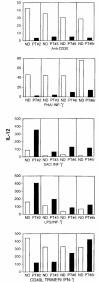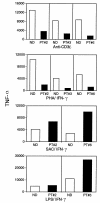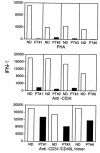Defects of T-cell effector function and post-thymic maturation in X-linked hyper-IgM syndrome
- PMID: 10207167
- PMCID: PMC408278
- DOI: 10.1172/JCI5891
Defects of T-cell effector function and post-thymic maturation in X-linked hyper-IgM syndrome
Abstract
X-linked hyper-IgM syndrome (XHIM) results from mutations in the gene encoding for CD40 ligand (CD154). Patients with the syndrome suffer from infections with opportunistic pathogens such as Cryptosporidium and Pneumocystis carinii. In this study, we demonstrate that activated T cells from patients with XHIM produce markedly reduced levels of IFN-gamma, fail to induce antigen-presenting cells to synthesize IL-12, and induce greatly reduced levels of TNF-alpha. In addition, we show that the patients' circulating T lymphocytes of both the CD4(+) and CD8(+) subsets contain a markedly reduced antigen-primed population, as determined by CD45RO expression. Finally, we demonstrate that the defects in antigen priming are likely due to the lack of CD154 expression and insufficient costimulation of T cells by CD80/CD86 interactions. Taken together, this study offers a basis for the increased susceptibility of patients with XHIM to certain opportunistic infections.
Figures






Similar articles
-
Absence of CD40-CD40 ligand interactions in X-linked hyper-IgM syndrome does not affect differentiation of T helper cell subsets.Clin Exp Immunol. 2000 Aug;121(2):346-52. doi: 10.1046/j.1365-2249.2000.01307.x. Clin Exp Immunol. 2000. PMID: 10931152 Free PMC article.
-
CD40 ligand-deficient T cells from X-linked hyper-IgM syndrome carriers have intrinsic priming capability.J Immunol. 2002 Feb 1;168(3):1473-8. doi: 10.4049/jimmunol.168.3.1473. J Immunol. 2002. PMID: 11801691
-
CD154 and type-1 cytokine response: from hyper IgM syndrome to human immunodeficiency virus infection.J Infect Dis. 2002 Feb 15;185 Suppl 1:S83-9. doi: 10.1086/338003. J Infect Dis. 2002. PMID: 11865444 Review.
-
Defective antigen-induced lymphocyte proliferation in the X-linked hyper-IgM syndrome.J Pediatr. 1997 Jul;131(1 Pt 1):147-50. doi: 10.1016/s0022-3476(97)70139-2. J Pediatr. 1997. PMID: 9255207
-
[From gene to disease; CD40 ligand deficiency as the cause of X-linked hyper-IgM-syndrome].Ned Tijdschr Geneeskd. 2003 May 24;147(21):1009-11. Ned Tijdschr Geneeskd. 2003. PMID: 12811971 Review. Dutch.
Cited by
-
CD40 agonist antibody mediated improvement of chronic Cryptosporidium infection in patients with X-linked hyper IgM syndrome.Clin Immunol. 2012 May;143(2):152-61. doi: 10.1016/j.clim.2012.01.014. Epub 2012 Feb 7. Clin Immunol. 2012. PMID: 22459705 Free PMC article. Clinical Trial.
-
X-linked Hyper IgM Syndrome Presenting as Pulmonary Alveolar Proteinosis.J Clin Immunol. 2016 Aug;36(6):564-70. doi: 10.1007/s10875-016-0307-0. Epub 2016 Jun 20. J Clin Immunol. 2016. PMID: 27324886
-
Establishment of adult peripheral blood lymphocyte subset reference range for an Asian population by single-platform flow cytometry: influence of age, sex, and race and comparison with other published studies.Clin Diagn Lab Immunol. 2004 Jan;11(1):168-73. doi: 10.1128/cdli.11.1.168-173.2004. Clin Diagn Lab Immunol. 2004. PMID: 14715565 Free PMC article.
-
Recent advances in transplantation for primary immune deficiency diseases: a comprehensive review.Clin Rev Allergy Immunol. 2014 Apr;46(2):131-44. doi: 10.1007/s12016-013-8379-6. Clin Rev Allergy Immunol. 2014. PMID: 23832379 Review.
-
Mechanotransduction governs CD40 function and underlies X-linked hyper-IgM syndrome.Sci Adv. 2024 Nov 15;10(46):eadl5815. doi: 10.1126/sciadv.adl5815. Epub 2024 Nov 15. Sci Adv. 2024. PMID: 39546606 Free PMC article.
References
-
- Callard RE, Armitage RJ, Fanslow WC, Spriggs MK. CD40 ligand and its role in X-linked hyper-IgM syndrome. Immunol Today. 1993;14:559–564. - PubMed
-
- Notarangelo LD, Duse M, Ugazio AG. Immunodeficiency with hyper-IgM (HIM) Immunodefic Rev. 1992;3:101–122. - PubMed
-
- DiSanto JP, Bonnefoy JY, Gauchat JF, Fischer A, deSaint Basile G. CD40 ligand mutations in X-linked immunodeficiency with hyper-IgM. Nature. 1993;361:541–543. - PubMed
-
- Allen RC, et al. CD40 ligand gene defects responsible for X-linked hyper-IgM syndrome. Science. 1993;259:990–993. - PubMed
MeSH terms
Substances
LinkOut - more resources
Full Text Sources
Medical
Research Materials

